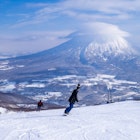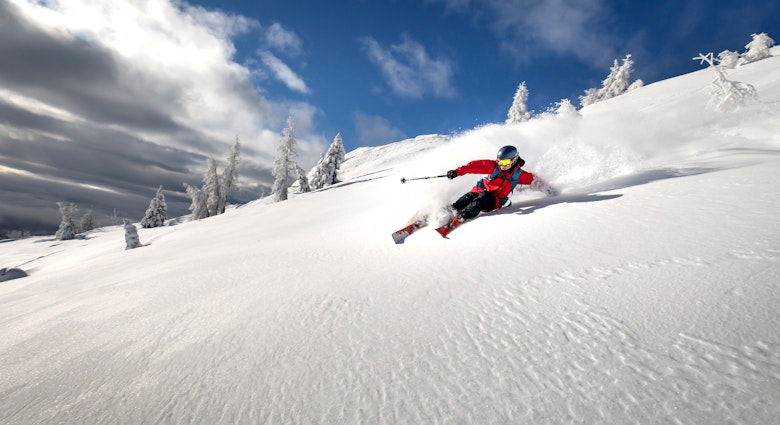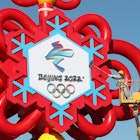

From budget slopes in Bulgaria to après ski in Austria, here are Europe's best places to ski. Nicola Colombo/Getty Images
Finding the perfect place to ski in Europe is like falling in love. My first experience was in Avoriaz in France. I was slopeside eating a melted raclette panini – bubbling and oozing in my gloved hand – with the sweet tang of local cheese like a hot gourmet love letter. Surrounded by lyrical accents, fang-like mountains and toe-tapping techno, Cupid’s arrow hit my heart. Somewhere, your ski-slope love affair is waiting to be discovered.
And there’s a blizzard of choice out there. Among the starring peaks (like Verbier and Val d’Isère) you’ll find spots that would be headline acts anywhere else: quiet achievers like the 25 linked resorts of Ski Amadé (named after nearby Salzburg-local Mozart) or Switzerland’s sweet little Bettmeralp.
So whether you’re seeking lonely lift lines or buzzing après-ski dance floors, we’ll help you find the perfect place in Europe to plant your poles.
1. Selva, Italy
Best for distance
Breakfast in France’s La Rosière and lunch in Italy’s La Thuile? Sign me up. In Italy's Dolomites, take a 40km (25-mile) "ski-fari" around the Sella Ronda, skiing your way from resort to resort using only one ski pass. Circling the huge limestone formation of the Sella massif, the route dips through four culturally ancient Ladin valleys and five mountain passes. You can keep your ski or board permanently attached — and even get towed by a horse through the Hidden Valley.
There are other, longer ski circuits in the region, like Ski Alberg’s 85km (53-mile) Run of Fame, and the 12 Portes Du Soleil resorts straddle both France and Switzerland, but the Sella Ronda’s drawcard is that it’s in Italy, where skiers can combine la dolce vita with stunning Dolomites scenery.
Formed by a giant prehistoric coral reef 200 million years ago, the UNESCO-listed mountains are streaked in a myriad of hues – catch the dawn and dusk enrosadira phenomenon, or alpenglow, when the rocky peaks blush pink.
Selva is the perfect base in Val Gardena, with direct access to the Sella Ronda via the Costabella chair lift. Bonuses include nearby tiny towns like church-studded Ortisei.
Best alternative for distance: Limber up for Les Trois Vallées, the largest interlinked ski area in Europe with over 600km (373 miles) of pistes. Base yourself in charming Méribel in the heart of the valleys for all area access.

2. St Anton, Austria
Best for après ski
Bare-chested, bearded mountain men dance on tables and no one even notices. Slopeside at St Anton’s MooserWirt — one of the wildest après outposts in Austria, if not the world — the crowd goes crazy like a Eurovision audience drinking schnapps shots and steins of beer. It’s an outdoor, joyful mass of humanity living their best lives, encapsulating Austria in a nutshell — or a shot glass. Imagine a funfest of people dancing like it’s 1999 to a playlist that is often from 1999.
The 3pm après bar crawl starts along Piste 1, beginning at relatively tame Heustadl and continuing to Sennhütte before culminating at the full-tilt MooserWirt. Pro tip: finding your skis post-party is like wading through metal avalanche debris. Stow them somewhere memorable.
The ski area itself (part of Ski Arlberg) is an amphitheater of frozen peaks soaring like static sails, where the gourmet experiences are as hectic as the afternoon shenanigans (don’t miss deliciously sweet Kaiserschmarren pancakes at the Alm Hospitz).
Best alternative for après ski: Head to the cumbersomely named Skicircus Saalbach-Hinterglemm-Leogang-Fieberbrunn, which boasts more than 30 bars. Try the locally distilled Bartl Enn Schnapps, regarded as some of Europe’s best.
3. Crans Montana, Switzerland
Best for freestylers
“Build it and they will come”, believed 20-something Alaïa Chalet founder Sam Bonvin, and he was right. Well known as the home of Bond actor Roger Moore, Crans Montana (until 2017 it was two villages of upmarket Crans and Montana), is experiencing a generational twist where fur-wearing is out and froth is in.
Bonvin’s one-stop-freestyle-spot Alaïa Chalet was a catalyst with trampolines, indoor skate ramps, foam pits, bowls outdoor skatepark, lodge, action sport camps and Alaïa Bay, a mechanical surf pool.
Up on the 150km (93 miles) of slopes, the resort cemented its freestyle status by hosting Red Bull’s 2022 The Nines event, prompting the low-pant-wearing brigade to arrive carting GoPros and fresh energy with them. The Alaïa Parks by Tudor is the largest snowpark in Western Switzerland, boasting a Main Park stretching 100,000 sq m (1,076,391 sq ft) over two sites.
In the town, creative urban art from the Vision Art Festival (including over 80 murals) mixes with traditional carvings, creating a tale of old happily meeting new.
Best alternative for freestylers: Watch the Mottolino Snowpark in Livigno in Italy as it ramps up to host the Milano Cortina 2026 Olympic freestyle competition.

4. Borovets, Bulgaria
Best for budget skiers
A bang-for-your-buck bonanza with lift tickets for but 85 lv (€43, or $47), Bulgaria is a hands-down winner for budget skiers. The former aristocratic playground of Borovets was tarred by the UK-tour-package push in the 2000s, but post-pandemic it’s been rediscovered as having all the trimmings. It’s located about an hour from Sofia airport, and has a ski school and rentals. Plus, eating out nightly costs half the price of a catered chalet in France.
Beginners seeking low-cost commitment are the main market and the skiing terrain of 58km (36 miles) with a longest run of 12km (7.5 miles) among atmospheric pine forests over-delivers. Regarding the village, the main drag is a package holiday town on snow, with a smattering of currency converters, English-style bars and local-style tavernas called mehana with traditional food and music.
Best alternative for budget: Bansko is a cosmopolitan step up with notable nightlife (visualize roaming saxophonists at après), a cobblestone town and even a Kempinski hotel. It costs more than Borovets, but you get what you pay for.
5. Zermatt, Switzerland
Best for non-skiers
If you know someone on the brink of joining the snow tribe, Zermatt will entice them over the edge with mountain-focused, non-skiing encounters.
The car-free glamorpuss of Zermatt is known to skiers for the omnipresent Matterhorn, the highest lifted ski point in Europe (3899m/12,759ft) and 360km (223 miles) of riding.
But the big news for non-skiers is the Glacier II gondola opening, the final link of the Matterhorn Alpine Crossing connecting Swiss Zermatt to Italy’s Breuil-Cervinia. The 90-minute trip includes the summit Glacier Paradise station and point-blank glacier views.
Then there’s the Matterhorn Museum – Zermatlantis, which tracks the village’s fortunes from poor farming hamlet to international magnet (including the broken rope from the Matterhorn’s tragic first ascent). Try wandering the 500-year-old Hinterdorf alley, with its crooked wooden buildings, and riding the 125-year-old Gornergrat cog railway to Europe’s highest-altitude hotel, the Kulmhotel Gornergrat.
Best alternative for non-skiers: Buzzing Chamonix in France is the grande dame of mountaineering, with a pedestrian main street, shopping, belle epoque architecture and Aigle du Midi cable car (3842m/12,604ft) up Mt Blanc.

6. Avoriaz 1800, France
Best for design lovers
Ah, Avoriaz. Love it or hate it, there’s nowhere like this futuristic, snowbound village perched on a spectacular balcony at 1800m (5905ft).
The location seems impossible, coiled like a cat poised to freefall into the Morzine Valley. And if the location doesn’t stun, the mimetic architecture will. The collection of acutely angled, red cedar shingle-covered buildings, each more bizarre than the last, melds organically with the mountain. Avoriaz was a wild gamble involving three renegade architects under 30 (Jacques Labro, Jean-Jacques Orzoni and Jean-Marc Roques) in 1966. It was built to be environmentally focused way before sustainability was a "thing," using passive heating principles and mainly natural materials.
With a seasonal snowfall average of around 7.5m (24ft), Avoriaz is France’s snowiest ski resort – a reason alone to visit. Throw in its Portes du Soleil address with linked slopes and a trip here becomes as unique as a Savoyard snowflake.
Best alternative for design lovers: The French went hard on brutalist high-altitude resorts in the '60s. Once maligned due to their appearance, ski areas like Val Thorens and La Plagne are now lauded as snow-sure, forward-thinking masterpieces.
7. Scandinavia
Best for early- and late-season skiing
Scandinavia is the cool kid on the block – literally – from blazing northern lights to traditional Sami ice-bound culture and remote wilderness. If you’re a passionate connoisseur of skiing, at some point, you’ll dig an edge into Scandinavia.
Think of a ski trip here as a winter holiday based around skiing rather than a pure ski trip. Imagine skiing in Levi, Finland under the Aurora Borealis, nuzzling reindeer after visiting Santa in Saariselkä or hitting peak hygge after a cold plunge and sauna basically anywhere.
SkiScandinavia is the local expert, organizing trips including to Sweden's largest alpine ski area, Sälen, and Norway's largest Alpine ski area, Trysil located either side of Scandinavia Mountains Airport.
Best alternative for early- and late-season skiing: Riksgränsen, a freeriding hot spot 16 hours’ drive north of Stockholm opens in February when the sun appears and stays open til midsummer, with skiing under the midnight sun.
Explore related stories






 SportsCould Uzbekistan become Central Asia’s first Shangri-La for skiers and snowboarders?
SportsCould Uzbekistan become Central Asia’s first Shangri-La for skiers and snowboarders?Mar 6, 2020 • 4 min read




